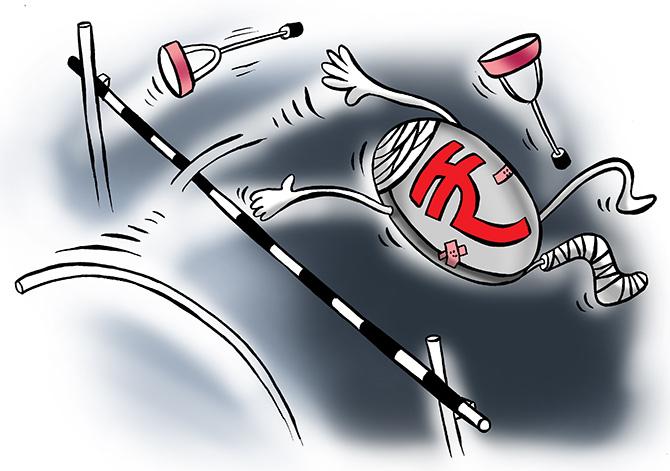 | « Back to article | Print this article |
Even with the possible expenditure roll-overs and off-budget financing, the fiscal deficit target will not be met. The FRBM Act, after its amendment in 2018, allows a fiscal deficit slippage of not more than 0.5 per cent for any given year, provided there are justifications.

The government is likely to miss its fiscal deficit target for 2019-20 (FY20) and the actual number could be anywhere between 3.5 per cent and 3.8 per cent of gross domestic product (GDP), as against the budgeted 3.3 per cent, top government officials told Business Standard.
A final call on the exact number will be taken by Finance Minister Nirmala Sitharaman and her Budget team after the advance tax numbers are available in mid-December, they said.
“The FRBM (Fiscal Responsibility and Budget Management) Act allows us to slip up to 3.8 per cent of GDP.
"We are aiming to be around 3.5 per cent, but it will depend on what sort of advance tax numbers we get,” said an official.
Another official conceded that meeting the 3.3 per cent target was now near impossible.
“Given the tax revenue situation, slippage can be quite big.
"The aim will be to keep it within the limits that the FRBM Act allows,” the person said.
This means that even with the possible expenditure roll-overs and off-budget financing, the fiscal deficit target will not be met.
The FRBM Act, after its amendment in 2018, allows a fiscal deficit slippage of not more than 0.5 per cent for any given year, provided there are justifications.
These justifications include war, national security, severe collapse in the agriculture sector, a major natural calamity, big structural economic reforms, or the decline in real output growth of a quarter by at least 3 percentage points below its average of the previous four quarters.
In absolute terms, the fiscal deficit target for the year is Rs 7.04 trillion.
For it to be 3.3 per cent of GDP, it assumes nominal GDP growth of 12 per cent in FY20.
As of end-October, the fiscal deficit stood at 102.4 per cent of the full-year target.
With the July-September GDP data available, it has been calculated that for the first half of 2019-20 (April-September), the fiscal deficit as a percentage of nominal GDP was 6.6 per cent.
Officials say that nominal GDP growth for the year will nowhere be close to 12 per cent.
Nominal GDP growth for April-June was 8 per cent and that for July-September, it was 6 per cent.
With the Reserve Bank of India’s latest forecast of 5 per cent real GDP growth for 2019-20, even a 3 per cent deflator will take nominal GDP growth to around 8 per cent.
That means that theoretically, even if the fiscal deficit for the year is Rs 7.04 trillion, as a percentage of GDP, it will shoot up to around 3.5 per cent.
Given the revenue scenario, that seems difficult.
While the divestment target is expected to be met and non-tax revenues could even be exceeded, tax revenues remain a major cause of concern and a shortfall of at least Rs 2 trillion is expected in gross tax revenue.
Central GST collection fell short of the budgeted estimate by nearly 40 per cent during the April-November period of 2019-20, according to the data presented in Parliament on Monday.
Actual CGST collection in this period stood at Rs 3.3 trillion, as against the budgeted estimate of Rs 5.26 trillion, Minister of State for Finance Anurag Singh Thakur said in a written reply in the Lok Sabha.
Corporation tax collection contracted by 1 per cent in April-November, compared with the same period last year, amid a slowing economy, even as the impact of the corporation tax rate cuts, announced in September, is yet to reflect in the numbers.
Direct tax collection, after adjusting for refunds, touched Rs 5.5 trillion at the end of November and will require a growth rate of 31 per cent in the remaining period to meet the Budget target of Rs 13.35 trillion.